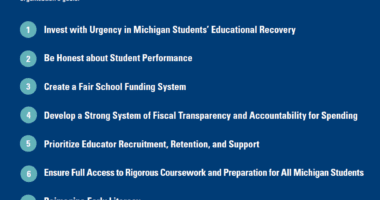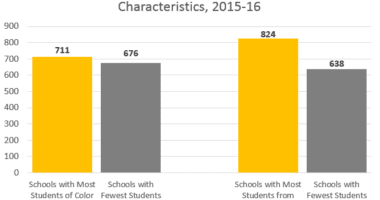Charter School Growth In Michigan Brings Cautionary Tale On Quality
Charter School Growth In Michigan Brings Cautionary Tale On Quality
Charter schools are the fastest-growing sector of public education, taking root in most U.S. states, thanks to a big push by the education reform lobby and the federal government’s Race to the Top competition. And since the movement’s inception in the early 1990s, its founders have learned a few things.
Across charter schools, there are similarities in what works to boost student achievement. A 2011 study identified five successes of charter schools: “frequent teacher feedback, the use of data to guide instruction, high-dosage tutoring, increased instructional time and high expectations.”
But just because charter schools have the flexibility to become successful in these ways doesn’t mean all of them meet those five criteria. In fact, most probably don’t.
Many charter school advocates are now taking stock of the fruits of their lobbying efforts, and finding that for the movement to succeed, it has to get better at policing its own duds. It’s hard to cobble together a coherent, quantitative answer to the question of whether charters live up to their funding levels across the country. But one state — an early believer in the promise of charter schools — offers a representative example.
Michigan has been at the center of charter school growth. In 1998-99, there were 138 charter schools in the state. This year, according to the National Alliance for Public Charter Schools, there are 280.
In the early 1990s, a small but influential group of Michigan politicians, professors and activists led by then-Gov. John Engler (R) had an idea: Public schools should focus more on the business of teaching and learning. They wanted to be able to make changes to schools happen faster, but the bureaucracy of school administration, they felt, was always standing in their way. Moreover, they didn’t think families and children should have to be confined to neighborhood schools — especially if those schools were failing.
So they launched an ambitious legislative effort to bring charter schools to Michigan. Charter schools, which are publicly funded but can be privately run, were a new concept at the time. The idea was that schools that proved their excellence should be independent — they should have more discretion over things like curriculum, teaching staff and the length of the school day.
Twenty years later, there is no comprehensive index of national charter school rankings. Without them, it’s hard to compare schools across state lines, especially because of differences in standardized tests. The closest thing to an answer is a trove of studies from Stanford University’s CREDO center. Its national study from 2009 found that, on average, charter schools are no better and no worse than public schools — but even that study only took a handful of states into account.
In Michigan, though, the evidence on charter school quality is clearer. Students in charter schools there perform worse on average than public school students, according to a 2007 study by Gary Miron, a professor at Western Michigan University. A CREDO study on Michigan released this week found that 80 percent of charters perform below the 50th percentile of achievement in reading, and 84 percent perform below that threshold in math. On top of that, according to the National Association of Charter School Authorizers, 26 percent of Michigan charter schools fall into the bottom 15 percent of the state’s schools on 8th grade math exams, and 21 percent in 8th grade reading.
“It’s disappointing for a lot of people here that had hoped that charters were really going to be the solution to urban children’s lack of quality options,” said Amber Arellano, who directs the nonpartisan advocacy group EdTrust Midwest. “They’re not. There are not enough high-performing charters here [in Michigan] to really address the educational inequities that we have here in the state. Just letting the market decide isn’t the answer.”
There are, however, signs of hope: the CREDO study found that Michigan’s charter school students learn at a faster rate, gaining about two months in reading and math knowledge over their public school peers annually.
Still, that study had its limitations: It didn’t measure most high school students, and, more important, it only covered up until the 2010-2011 school year, a pivotal time in charter school history in Michigan.
In 2011, the Michigan legislature, like several other states, voted to “uncap” its charter schools. This major step deregulated charters and removed limits to the number of such schools that can open in Michigan. With few other accountability measures in place, there’s no longer even the threat of competition to incentivize charter operators to improve their schools.
This year, after Michigan lifted its charter cap, 30 new schools opened — the largest year-over-year increase since 1999-2000. But according to an analysis EdTrust Midwest provided to HuffPost, the schools that opened up during that rush are likely less than stellar.
Many of those schools are run by operating companies that already had existing charters throughout the state. According to EdTrust, some of those operators have shoddy records. The group looked to see whether their existing schools were performing at the 33rd percentile of the state’s school ranking system. (They chose that level because it’s the state average for low-income students.) They found that of 15 charter operators that opened new schools this year and had track records in the state, seven did not even meet that low benchmark.
This worries Arellano. “Some of the worst operators in the state are the ones that are growing the fastest,” she said.
Greg Richmond, head of the National Association for Charter School Authorizers, was there at the beginning, and is invested in the movement’s success. Richmond worked with then-Chicago schools chief Arne Duncan (now U.S. Secretary of Education) to build up charter schools there. But he, too, has realized they’re not living up to their promise.
“The quality of schools in Michigan — what you’re seeing there is probably pretty nationally representative,” Richmond said in an interview. “I never thought that all charter schools were going to be great.”
Still, Richmond and other advocates disappointed by charter school quality are hopeful that the original promise can be restored. Despite the low averages in Michigan, there are examples of charter schools that defy the odds.
Richmond thinks states should get better at shutting bad charter schools down and is launching a campaign to get them to do so. In Michigan, Arellano is pushing for a solution to try to prevent those schools from opening in the first place.
When Michigan lifted its charter cap, a group of education organizations tried to urge the state to include quality controls. That measure failed in the Republican-dominated legislature. But these advocates are still pushing. “We think we need a really rigorous charter accountability framework,” Arellano said. “There’s still a demand for good charter schools.”





